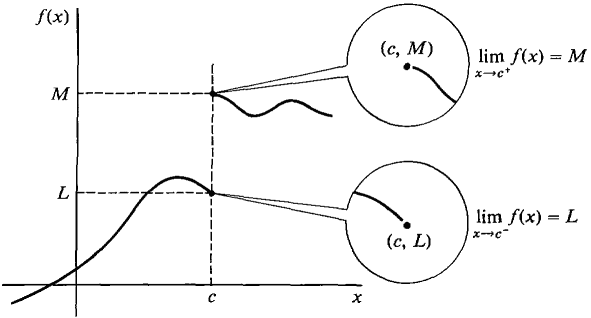| The ebook Elementary Calculus is based on material originally written by H.J. Keisler. For more information please read the copyright pages. |

|

Home  Continuous Functions Continuous Functions  Limits Limits  Theorem 2: One-sided Limits Theorem 2: One-sided Limits |
|||||||||||||






|
|||||||||||||
Theorem 2: One-sided Limits
In the above examples the function behaves differently on one side of the point 0 than it does on the other side. For such functions, one-sided limits are useful. We say that limx→c+ f(x) = L if whenever x > c and x ≈ c, f(x) ≈ L. limx→c- f(x) = L means that whenever x < c and x ≈ c, f(x) ≈ L. These two kinds of limits, shown in Figure 3.3.4, are called the limit from the right and the limit from the left.
Figure 3.3.4 One-sided limits. THEOREM 2 A limit has value L, lim f(c) = L, if and only if both one-sided limits exist and are equal to L, limx→c- f(x) = limx→c+ f(x) = L. PROOF If limx→c f(x) = L, it follows at once from the definition that both one-sided limits are L. Assume that both one-sided limits are equal to L. Let x ≈ c, but x ≠ c. Then either x < c or x > c. If x < c, then because limx→c- f(x) = L, we have f(x) ≈ L. On the other hand if x > c, then limx→c+ f(x) = L gives f(x) ≈ L. Thus in either case f(x) ≈ L. This shows that limx→c f(x) = L. When a limit does not exist, it is possible that neither one-sided limit exists, that just one of them exists, or that both one-sided limits exist but have different values.
|
|||||||||||||
Home  Continuous Functions Continuous Functions  Limits Limits  Theorem 2: One-sided Limits Theorem 2: One-sided Limits |
|||||||||||||
Last Update: 2006-11-05



